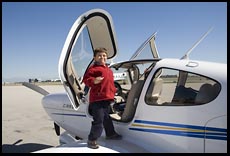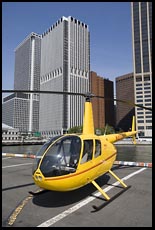

|
Ground Monitoring for Part 91 Operationsby Philip Greenspun in September 2008 |
 The pilot checks the weather, gets into the airplane, turns the key,
and flies off into the sunset/clouds/whatever. Most challenges that
occur in the air, such as thunderstorms, instrument conditions, icing,
or high crosswinds upon landing are predictable from the weather
briefing. The pilot is solely responsible for making the decision as
to whether to go or not go.
The pilot checks the weather, gets into the airplane, turns the key,
and flies off into the sunset/clouds/whatever. Most challenges that
occur in the air, such as thunderstorms, instrument conditions, icing,
or high crosswinds upon landing are predictable from the weather
briefing. The pilot is solely responsible for making the decision as
to whether to go or not go.
When a challenge does occur in-flight, the pilot must handle that problem him or herself while simultaneously keeping the airplane under control and communicating with Air Traffic Control via the radio. One problem with this requirement is that people tend to lose 30 IQ points as soon as they sit down in an aircraft cockpit. Arithmetic becomes difficult. Pilots develop tunnel vision, concentrating on a problem with flaps and not noticing that fuel is running low.
Pilots by themselves do things that seem remarkably stupid. They forget to put the landing gear down before landing ($30-60,000; bruised ego). They forget to switch fuel tanks and panic when one or more engines quit (often results in a catastrophic accident). They exceed various aircraft limitations. They press onward towards deteriorating weather and/or in the face of limited fuel.
The result of unexpected adverse mechanical or weather conditions is often an accident.
Once in the air, one pilot will be the "flying pilot" and the other pilot will be the "monitoring pilot". If bad weather or a mechanical problem arises, the flying pilot continues to fly the airplane, making sure that attitudes and airspeeds are reasonable. The monitoring pilot can put his or her head down, run checklists, throw switches, handle the radio.
The result of unexpected adverse mechanical or weather conditions is seldom an accident.
Prior to a flight, a dispatcher works to determine if a flight is going to be safe and legal. The dispatcher, who is trained to more or less the same standards of knowledge as a pilot, calculates an appropriate fuel load that will allow sufficient time to attempt an approach at the destination airport, fly to an alternate airport if necessary, and then continue to fly for 45 minutes afterwards. The dispatch release, which includes weather reports and forecasts, notices about runway closures, and fuel calculations, may be reviewed by the SIC and must be reviewed and signed by the PIC. Three people must agree before the airplane takes off.
In the air, the two airline pilots work much as the charter pilots do, with the exception that their dispatcher is watching the flight on a screen while sitting comfortably at a desk. If the pilots are given holding instructions and aren't sure if they will have enough fuel to hold, work their way around a few thunderstorms, and make it to the planned destination with adequate reserves, they can call the dispatcher. If the dispatcher sees that the flight is holding for a long time and becomes concerned, he or she can call the pilots and offer advice.
The dispatcher has a similar level of knowledge about weather and airplane capabilities as the pilots, but can be much more effective than the pilots because (1) the dispatcher is not sitting in an airplane and therefore has all of his or her original IQ, (2) the dispatcher has access to a high-speed Internet connection, a telephone, and various personal computer programs, and (3) the dispatcher does not need to keep the airplane flying.
The result of unexpected adverse mechanical or weather conditions is almost never an accident.
 Before launching a flight, the pilot would sit down at a Web browser
and fill out a planning form, much as he or she currently does to get
a weather briefing. A "ground monitor" copilot would be assigned to
the flight and the two pilots would confer via text or voice as to
whether or not the flight could be made safely.
Before launching a flight, the pilot would sit down at a Web browser
and fill out a planning form, much as he or she currently does to get
a weather briefing. A "ground monitor" copilot would be assigned to
the flight and the two pilots would confer via text or voice as to
whether or not the flight could be made safely.
Once the airplane was fired up it would connect to a ground- or satellite-based telemetry system. The ground monitor would see the airplane pop up in the system and request monitoring authority, resulting in a pop-up window on the multi-function display that the pilot would acknowledge.
The pilot and ground monitor would run the pre-takeoff checklists together, just as in the airline and charter world, connected via a voice link. The ground monitor would be in a position to note whether or not the airplane was properly configured for takeoff, e.g., with flaps, trim, lights, and fuel pump set appropriately.
On the climb-out, the ground monitor would be in a position to assist with a checklist and to point out, via a voice over the intercom, "you forgot to retract your landing gear" or "Do you really still want the flaps?" or "Best climb speed is 96 knots."
In cruise flight, the ground monitor would be available to check weather at alternate airports, make sure that the fuel reserves were still adequate, and remind the pilot to switch fuel tanks if necessary.
During the approach phase, the ground monitor would be able to point out deviations from the approach procedure, airspeed decaying, and aircraft configuration problems.
How about the communications link? The military can afford whatever it wants for the Predator drone, but what about us poor taxpayers? Because the U.S. has not invested in a universal wireless Internet, this would indeed be a cost challenge, but certainly communications costs are getting lower all the time.
How about paying ground monitors? The typical flight instructor is happy to work for $20 per hour. A lot of folks use flight simulators for hours every day without any compensation. If we assume that the average cost of operating a piston-powered airplane is $150 per hour, the cost of the ground monitor isn't significant even for those who operate the most economical four-seat airplanes.
Yes, it's surprising how long data networks in the air have taken. You would think a combination of the cellular network, a few extra towers (which unlike cell towers can be seen for hundreds of miles by private planes) and satellite backup could do the job. Of course they would charge pilots a fortune, because they can. Look what XM weather costs just for one little stream of data that's free on the ground, as much as all the radio stations, and it's one way.However, intermittent copilot could still be very useful. Of course you would have this copilot on takeoff and landing (easy data connection possible there) and in an emergency situation the cost of satellite bandwidth is not an issue. But you could also be updating the virtual copilot's console from time to time whenever you got in range of cheap connectivity. If the copilot saw an urgent situation they could reach you via something like XM or other satellite channels.
Most of these copilots need not be full time in your plane to be useful. One copilot might be working with 5 different flights at a time, this is still more than having no copilot. Combine that with a computerized copilot who not only assists the pilot but also predicts times that a ground copilot would be handy -- such as predicted fuel situations, weather situations, course changes, travel through tricky traffic areas. All these things can be predicted and your copilot could be there for them.
Of course, over time, the AI copilot will get as good as the ground one for most functions, certainly for all the things pilots commonly forget to do.
-- Brad Templeton, September 15, 2008
It's a good idea, but I think it's overly complicated and intrusive. While not all of the problems could be eliminated without this level of connectivity, some could.First, an initial pre-flight planning phase could be solved by a dispatch-like service that would take into account pilot experience and flying frequency (either initially provided or built from history of use,) and other things like equipment capability. It would be both a convenience and a safety resource, although the liability aspect would have to addressed somehow.
Then, a lot of the stupid-pilot-tricks components could be solved by cockpit integration. The ERJ145 balks at you when you're not in the right configuration for the specific phase of flight. This is not a difficult system to include in GA aircraft, it just requires a bit more integration. This could take care of the flap/gear/trim/fuel etc. issues.
I personally would prefer these choices to video-chatting in the cockpit with some guy I don't know, instilling zero confidence in my passengers.
-- Pilot John, September 16, 2008
Making private flights safer should be a priority for all. Although it may seem intrusive to some to have a person on the ground monitoring the flight, if this idea saves lives - it's worth the effort. I personally don't see the intrusiveness, and if your able to opt out, opt out. I think having several alternatives for pilots to choose from would be handy. You could have the ground monitoring for a fee, say a flat rate per flight based on destination or estimated time to destination (for privacy). You could have the co-pilot option (which to me seems more intrusive)for riskier flights or less experienced pilots, and then you could have a simulator, built in to the existing cockpit or as an add-on like my husbands GPS and various monitoring equip. on his boat. This third option could be a virtual co-pilot which makes recommendations based on what is relayed from the planes computer system and other functioning monitoring devices. It could be generic, or able to integrate seamlessly - not proprietary...that would be like auto-pilot but auto-copilot.
-- Tamayco DeHart, December 8, 2008
I love this idea!It is a well known fact in general aviation that pilots (Part 91) are at their best behavior when an examiner is seated in the right seat. This idea is trying to mimic that situation. I feel that having ANY two pilots cuts down the risk of a disaster because most disasters results from not one, but generally a series of unrecognized/uncorrected errors and two pilots are unlikely to miss things easily.
-- Akhilesh Pandey, February 2, 2009
I like this idea of a ground-monitoring co-pilot very much, but I suspect the real-time communications issues will delay its implementation. Another issue is that many pilots will probably fight the deployment of such a system. Even if the system was optional and participation was voluntary, if it worked, the FAA might move towards making it mandatory. Independent private pilots are likely to fight.OK, so I don't have much hope that this ground monitoring system will become available soon to help me be a safer pilot. However I wonder if a large portion of the potential benefits might be available from an robotic co-pilot. Suppose Garmin (or other computerized instrument manufacturer) added some intelligence to their on-board software. Many of the problems of distraction and forgetfulness can be detected by an on-board, automated monitoring system. Things like gear-up landings should be highly improbable if the on-board monitor knows the destination airport, the fact that you are making an approach and have passed through the gear deployment altitude. "Hey Chris, your gear is still up, are you sure you'd like to make a gear-up landing?" Similarly, electronic weather analysis, icing condition detection, fuel usage, terrain avoidance, etc, etc.
I'd like to see a digitally encoded weather information download combined with a detailed set of flight sensors and an easy flight plan data entry system. The on-board computer should be able to follow my flight and notify me about any discrepancies. The plane could check fuel levels, alternate airports, measure the weight and balance of the plane, and monitor weather and winds along the route.
None of this requires much in the way of improved communication infrastructure. Just add a few bits to the XM weather channel and a few more sensors to the airframe and a lot of new software. The pilot should not be able to 'not notice' a problem for which the computer has sensors.
Chris
-- Chris Uhlik, February 16, 2009
I agree that having a second set of eyes would be helpful, but it could and should be handled by the aircraft. There's no reason the aircraft cannot go through the flight planning with the pilot (this could happen via the web, with the resulting plan uploaded into the automated co-pilot) so that it understands what should happen. It could assist with the various checklists during all stages of flight, along with monitoring the aircraft, weather, traffic.The technology to do this is readily available, and following the PIC/SIC principle, the automated co-pilot could offer suggestions to the pilot, but ultimately it would be up to the pilot to assess the situation and develop a plan of action to react to it.
The advantage of the auto-SIC is that it would have perfect knowledge of the procedures for dealing with the various types of situations, and can remind the pilot to (for example) turn off the fuel pump and tank switch during an emergency landing. These hints would be invaluable to a panicked pilot and could prevent a lot of accidents, or limit their extent.
-- Brad Koehn, September 4, 2009
Looks like your cool idea will come to fruition! http://www.flyingmag.com/avionics-gear/pilot-supplies/smart-sidekick-redbird?cmpid=enews072015&spPodID=030&spMailingID=23090816&spUserID=NDc4NjE3NDI1NwS2&spJobID=601979901&spReportId=NjAxOTc5OTAxS0
-- Brian Ucsd, August 3, 2015